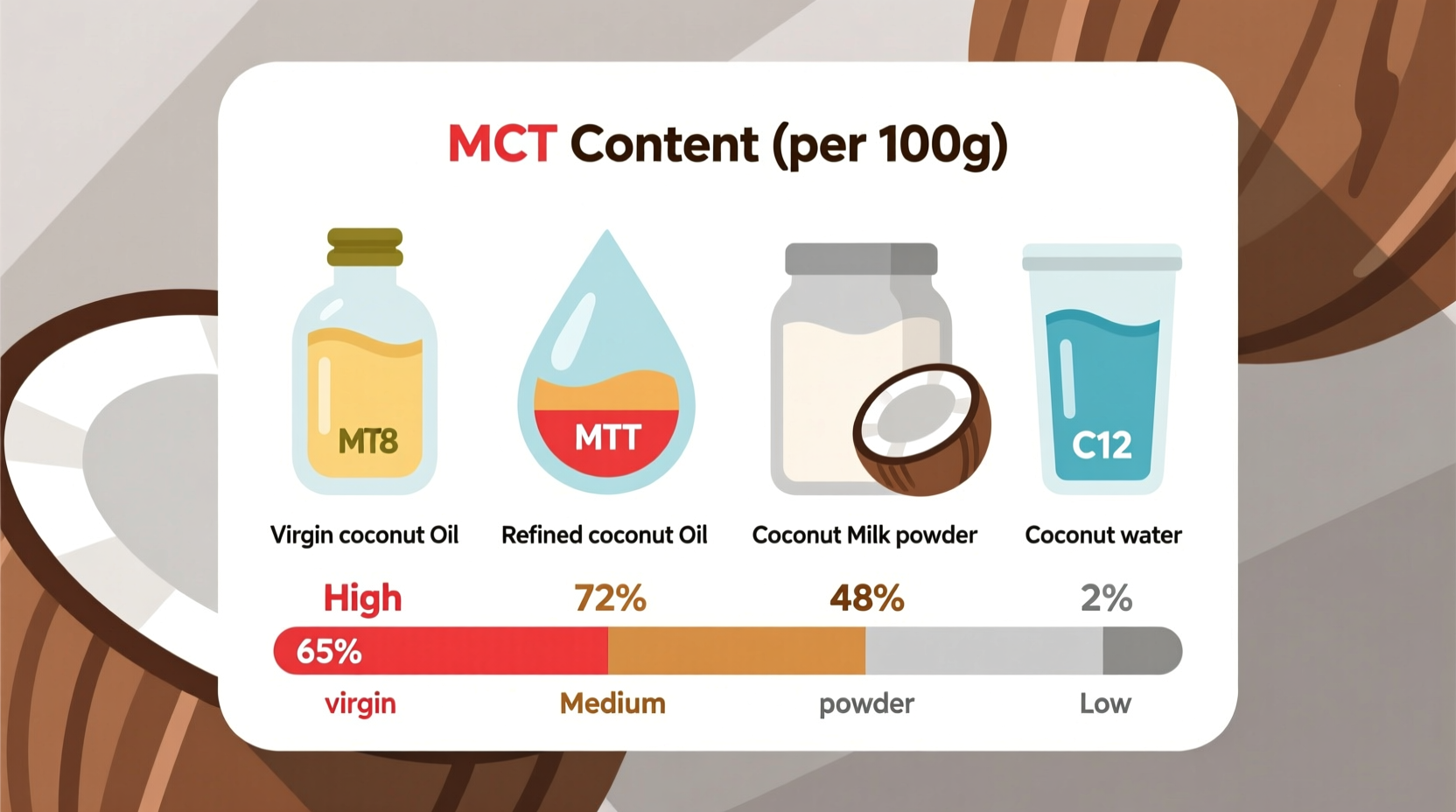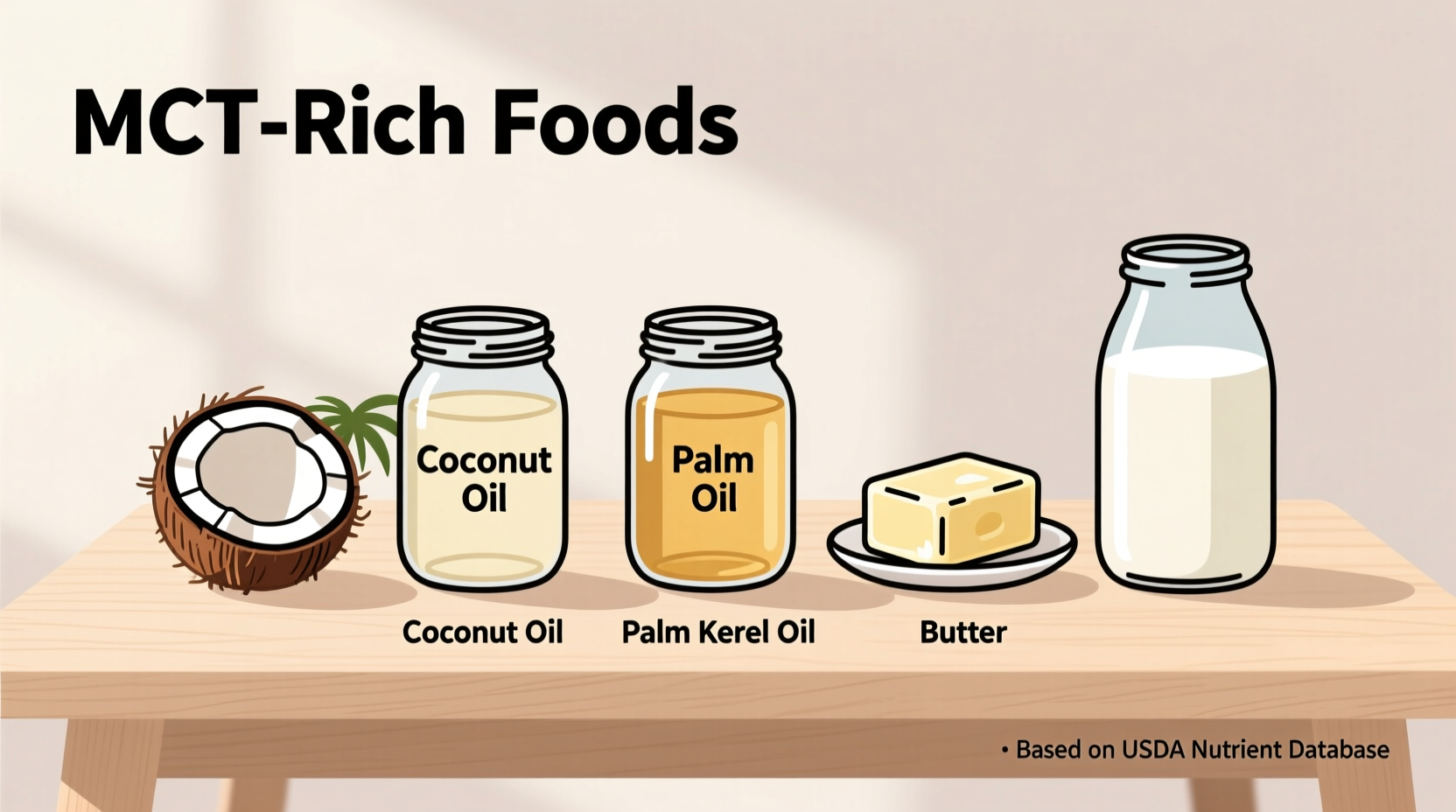Naturally occurring MCTs (Medium-Chain Triglycerides) are primarily found in coconut products (50-65% of fat content), palm kernel oil (about 50%), and dairy fats (6-10%). These foods provide the most significant dietary sources of caprylic acid (C8), capric acid (C10), and lauric acid (C12) without supplementation.
Discover exactly which foods contain naturally occurring MCTs and how to incorporate them into your diet for optimal health benefits. This comprehensive guide reveals the top food sources backed by nutritional science, helping you make informed choices whether you're following a ketogenic diet, seeking cognitive enhancement, or simply optimizing your nutrition.
Understanding MCTs: More Than Just a Supplement Trend
Medium-Chain Triglycerides (MCTs) are unique fats metabolized differently than long-chain triglycerides. Unlike most dietary fats that require bile for digestion, MCTs go directly to your liver where they're rapidly converted into ketones—providing quick energy for your brain and body. While MCT oil supplements dominate the market, several whole foods naturally contain these beneficial fats.
According to the USDA FoodData Central, the primary MCTs found in foods include caproic acid (C6), caprylic acid (C8), capric acid (C10), and lauric acid (C12). Lauric acid (C12), while technically a medium-chain fat, behaves more like a long-chain fat in the body, which explains why coconut oil—despite containing 50-65% MCTs—doesn't provide the same immediate ketone-boosting effects as purified C8 or C10 supplements.
Natural Food Sources of MCTs: What the Research Shows
When evaluating foods for MCT content, it's crucial to distinguish between total fat content and the percentage of that fat that consists of medium-chain triglycerides. Many foods contain small amounts of MCTs, but only a few provide significant quantities.
| Food Source | Total Fat Content | MCT Percentage of Total Fat | Primary MCT Types |
|---|---|---|---|
| Coconut oil | 100% | 50-65% | Lauric acid (C12) 40-50%, Caprylic (C8) 5-10%, Capric (C10) 5-8% |
| Palm kernel oil | 100% | ~50% | Lauric acid (C12) 45-55% |
| Whole milk | 3.25% | 6-10% | Caproic (C6), Caprylic (C8), Capric (C10) |
| Butter | 80% | 8-12% | Caproic (C6), Caprylic (C8), Capric (C10) |
| Goat milk | 3.5-4.5% | 15-20% | Caproic (C6), Caprylic (C8), Capric (C10) |
Coconut: The Undisputed Champion of Natural MCTs
Coconut products deliver the highest natural concentration of MCTs among commonly consumed foods. Research published in the Journal of Functional Foods confirms that coconut oil contains approximately 54% lauric acid (C12), making it the richest natural source. While lauric acid doesn't convert to ketones as efficiently as C8 or C10, it offers significant antimicrobial benefits.
When selecting coconut products for MCT content:
- Unrefined coconut oil provides the highest concentration (50-65% MCTs)
- Full-fat coconut milk contains about 24% fat with similar MCT percentages
- Shredded coconut offers approximately 33% fat with proportional MCT content
- Coconut flour contains minimal fat and thus negligible MCTs

Dairy: The Often Overlooked MCT Source
While dairy fats contain a smaller percentage of MCTs compared to coconut, they offer a more balanced fatty acid profile. According to the FDA's Dairy Nutrition Facts, butter contains 8-12% MCTs of its total fat content, with goat dairy products typically containing higher concentrations (15-20%).
The MCTs in dairy primarily consist of the shorter-chain varieties (C6, C8, C10) that convert more efficiently to ketones than lauric acid. This makes dairy an excellent choice for those seeking immediate cognitive benefits from MCTs without supplementation.
Practical Applications: Incorporating MCT-Rich Foods
Understanding which foods contain MCTs is only valuable when you can apply this knowledge. Here's how to maximize MCT intake through whole foods:
For Ketogenic Dieters
Replace standard cooking oils with coconut oil for high-heat cooking. Add full-fat coconut milk to smoothies or curries. Incorporate grass-fed butter into your morning coffee for a natural MCT boost that supports ketone production without the digestive issues some experience with concentrated MCT oil.
For Cognitive Enhancement
Choose dairy sources like grass-fed butter or goat cheese for snacks. The shorter-chain MCTs in dairy convert to ketones more rapidly, providing quicker cognitive benefits. A study from National Institute on Aging suggests these ketones serve as an efficient brain fuel, potentially supporting cognitive function.
For General Health Optimization
Rotate between coconut and dairy sources to benefit from the antimicrobial properties of lauric acid while still gaining the metabolic advantages of shorter-chain MCTs. This approach provides a more balanced nutritional profile than relying solely on supplements.
Common Misconceptions About MCTs in Foods
Several myths persist about MCT content in foods that deserve clarification:
- MCT oil is naturally present in high concentrations in many foods - Reality: Only coconut and palm kernel oils contain significant natural MCT concentrations; most other foods contain minimal amounts
- All coconut products are equally rich in MCTs - Reality: MCT content varies significantly between coconut oil, milk, water, and flour
- Lauric acid (C12) provides the same benefits as C8 and C10 - Reality: Lauric acid metabolizes differently and doesn't produce ketones as efficiently
- Dairy fats don't contain meaningful MCTs - Reality: Dairy contains the shorter-chain MCTs that convert more efficiently to ketones
Maximizing Benefits While Avoiding Pitfalls
When incorporating MCT-rich foods, consider these practical guidelines:
- Start with small amounts of coconut oil (1-2 tsp) to assess tolerance
- Combine MCT-rich foods with fiber to support digestion
- Avoid heating coconut oil beyond its smoke point (350°F/177°C)
- Rotate between coconut and dairy sources for balanced benefits
- Don't expect the same immediate effects from whole foods as from purified MCT oil
Remember that individual responses to MCTs vary significantly based on gut microbiome composition and metabolic health. A review in National Center for Complementary and Integrative Health literature notes that some people experience gastrointestinal discomfort when introducing MCT-rich foods too quickly.
Your MCT-Rich Food Journey Starts Today
By understanding which foods naturally contain MCTs and how to incorporate them strategically, you can harness these beneficial fats without relying solely on supplements. Whether you're optimizing for cognitive performance, metabolic health, or general wellness, these whole food sources provide a sustainable approach to MCT consumption backed by nutritional science.











 浙公网安备
33010002000092号
浙公网安备
33010002000092号 浙B2-20120091-4
浙B2-20120091-4